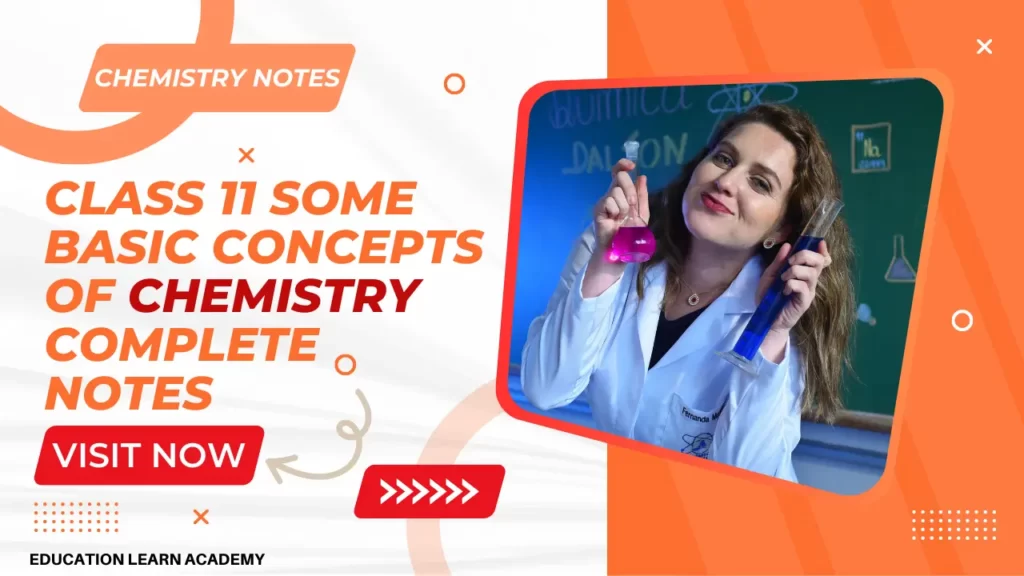
Class 11 Some Basic Concepts of chemistry Complete Notes: In this post, we will go over some fundamental chemical topics. This is the first chapter of 11th grade chemistry, and it is also an important chapter for board and school exams. Overall, in this post, we will examine several basic chemical principles in brief, and you can also grab the comprehensive notes pdf from this page.
Before you download the PDF, take a look at some basic and crucial subjects covered in class 11 Chemistry.

Chemistry is a fascinating part of science that investigates matter’s constitution, properties, and transformations. As a Class 11 student, it is critical to understand the fundamental ideas of chemistry in order to lay a solid basis for more advanced studies.
To help you learn these key principles properly, we will give you with thorough notes, an information table, and answers to some frequently asked questions in this article.
Best Tutorial Watch on Youtube
I. Matter and Its Classification:
- Definition of matter: Anything that occupies space and possesses mass.
- Classification of matter: Pure substances and mixtures. a. Pure substances: Elements and compounds. b. Mixtures: Homogeneous and heterogeneous mixtures.
II. Elements and Compounds:
- Elements: a. Definition: Compounds that are unable of being broken down into simpler compounds using standard chemical processes. b. Illustrations: Carbon, oxygen, hydrogen, etc. c. Physical and chemical characteristics of elements.
- Compounds: a. Substances made up of two or more elements that have been chemically mixed in a certain order.
- b. Examples are sodium chloride (NaCl), carbon dioxide (CO2), water (H2O), and others.
- c. Compound attributes are distinct from those of the individual constituent elements.
III. Atoms, Molecules, and Ions:
- Atoms are the smallest particles of an element that yet have its chemical characteristics. b. The nucleus (protons and neutrons) and electron cloud make up the structure of an atom.
- Molecules: a. Chemically bound groups of two or more atoms are referred to as molecules. Diatomic and polyatomic molecules are two different types of molecules.
- Ions are charged particles that originate when electrons are gained or lost. Cations are positive ions, and anions are negative ions.
IV. Chemical Reactions and Equations:
- Definition: A process that includes the rearrangement of atoms to generate new substances.
- b. Chemical reaction indicators: gas evolution, precipitate development, colour change, and so forth.
- Chemical equations: a. Symbolic and formulaic representation of a chemical reaction. b. Chemical equation balancing: ensuring mass conservation.
V. Stoichiometry:
- In a chemical process, the quantitative relationship between reactants and products.
- Stoichiometry calculations include the mole concept, molar mass, mole ratios, limiting reactants, and percent yield.
VI. Atomic Structure and Periodic Table:
- Protons, neutrons, and electrons are the subatomic particles that make up an atom.
- b. Electronic configuration: How electrons are arranged in orbitals and energy levels.
- The periodic table is used to categorise elements according to their atomic weight and electron configuration. b. Timeframes, social groups, and emblematic components.
Information Table: (Table format) Topic | Definition | Examples
| Topic | Definition | Examples |
|---|---|---|
| Matter | Anything that occupies space and possesses mass | Air, water, iron |
| Elements | Substances that cannot be broken down into simpler substances by ordinary means | Oxygen, hydrogen |
| Compounds | Substances composed of two or more elements chemically combined in fixed ratios | Water (H2O), sodium chloride (NaCl) |
| Atoms | Smallest particle of an element | Carbon atom (C) |
| Molecules | Groups of atoms held together by chemical bonds | Oxygen molecule (O2) |
| Ions | Charged particles formed by gaining or losing electrons | Sodium ion (Na+), chloride ion (Cl-) |
FAQs:
Q1: What is the difference between an element and a compound?
Q2: How are atoms and molecules different?
Q3: What are chemical reactions and equations?
How do you define stoichiometry?
How do you define the periodic table?
Some Basic Concepts Of chemistry Notes Pdf Download
| Some Basic Concepts Of chemistry (Notes) | DOWNLOAD NOW |
Conclusion:
Mastering the basic concepts of chemistry is essential for Class 11 students.
By understanding the properties of matter, elements, compounds, atoms, molecules, chemical reactions, stoichiometry, and the periodic table, you will be well-equipped to explore more complex topics in chemistry.
Use the provided information table and address any lingering questions through the FAQs to solidify your understanding. Enjoy your journey into the fascinating world of chemistry!






![[PDF] Zumdahl Chemistry 10th Edition Free PDF Download](https://i0.wp.com/educationlearnacademy.in/wp-content/uploads/2022/11/PDF-Zumdahl-Chemistry-10th-Edition-Free-PDF-Download.webp?resize=958%2C575&ssl=1)
![[PDF DOWNLOAD] Prabhat NTA CUET UG Guides and Practice Papers All Subjects Free Pdf](https://i0.wp.com/educationlearnacademy.in/wp-content/uploads/2022/06/PDF-Prabhat-NTA-CUET-UG-Guides-and-Practice-Papers-All-Subjects-Latest-Free-Pdf-Download.png?resize=958%2C575&ssl=1)
